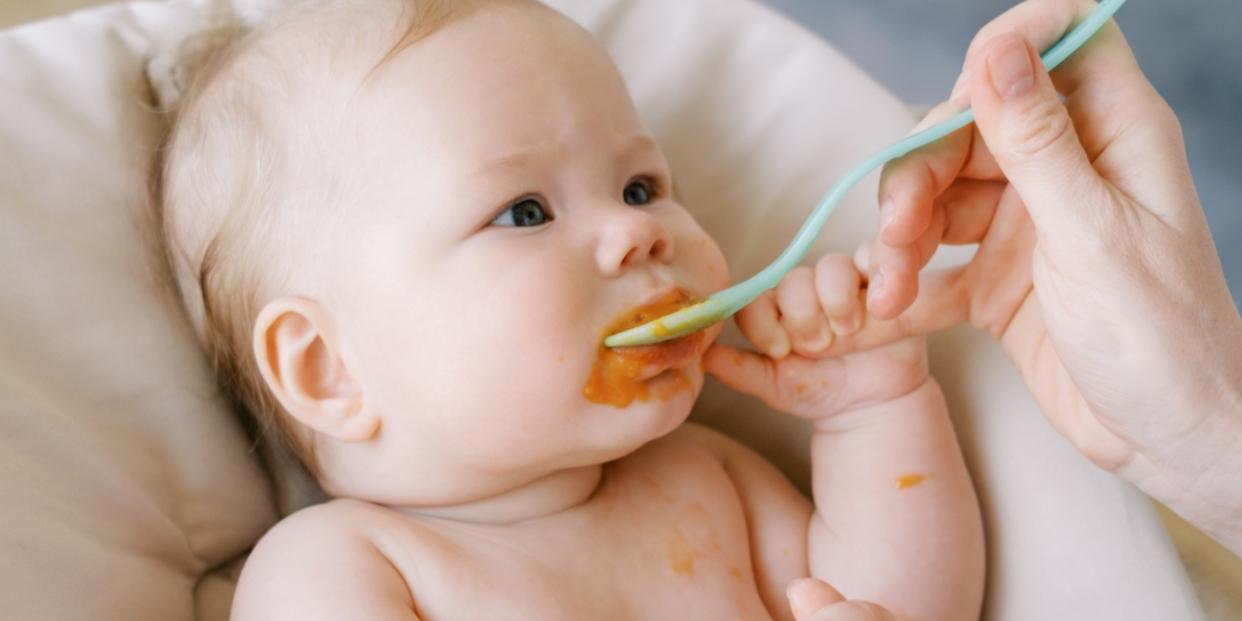What to do if your baby isn’t interested in solids

When I introduced solid foods to my first child, it was as if she snagged a spot on a foodie reality show. She dove into solid foods with an appetite of a mini gourmet adventurer, eagerly exploring new flavors and textures. Roasted beets with zaatar? Sure! Curried cauliflower? More please!
Fast forward a few years and I was genuinely surprised that my next two kiddos weren’t as thrilled about food. I’m in the kitchen, whipping up a delicious bowl of pureed banana (with a dash of cinnamon and vanilla, of course) and they’re looking at me like I just handed them a bowl of mystery goo. Seriously, aren’t they tired of a milk-only diet?
As I’ve (humbly) learned over the years, every baby is different, and some need extra time to navigate this new sensory journey. If you’re currently engaged in a standoff with your little one over mushy avocado slices, here are a few simple tips to spark your baby’s curiosity and make the transition to solid foods a whole lot easier.
Recognize that babies have small bellies
When you catch those adorable baby commercials featuring babies joyfully devouring heaps of food, it’s important to remember that, in reality, babies don’t eat much when they start solids. Oftentimes, parents get excited about introducing solids, only to discover that their baby’s interest fizzles out after just a few bites. One or two spoonfuls might be all your baby needs. Instead of thinking it’s a lack of interest, celebrate those few precious bites!
Here’s a helpful tip: give a 30 to 90 minute breather between milk and solid feeds. Find that sweet spot when your baby’s hungry for solids but not too full from milk. As your little one grows and becomes a foodie in training, their appetite will expand. Set them up for success by finding the perfect balance that keeps them happily munching away.
Model the behavior you want to see
Babies are like little sponges, soaking up everything around them and picking up valuable lessons along the way. One way to spark your baby’s interest in solids is by being a mealtime role model. Babies love imitating their parents, and it’s a surefire way to boost their appetite and curiosity about food. After all, they’re eager to be just like us!
Model eating for your baby:
Use animated, exaggerated motions and sounds while you’re eating. Go all out with loud chomps, a satisfied ‘ah’ after each swallow, and demonstrate that eating is not only tasty but also a lively, interactive experience.
When modeling, munch on the same food you’re serving your baby. If your baby is eating banana spears, join in on the banana feast yourself.
Serve family-style meals to give your baby another opportunity to observe food and grasp the rhythm of mealtime routines.
Your baby may want to self-feed
Your baby may be more interested in self-feeding, whether you started solids with purees or went full on baby-led weaning. If you notice your baby giving you the side-eye during spoon-feeding sessions, try handing them a pre-loaded spoon of purees instead. A simple change in serving style can jazz up your baby’s interest in eating.
Let them get messy!
Taste is one of the more intense sensory experiences, and for babies, that can sometimes be overwhelming (watch out, sensory overload!). They might need to ease into it using their trusty sidekicks, smell and touch, before diving into the tasting journey.
Enter the world of food play. Babies familiarize themselves with new foods by getting hands-on, touching, smelling and creating messy masterpieces. And guess what? This playful exploration can eventually lead to that first taste. Throw some blueberry oatmeal on their tray, let them turn it into a canvas, and watch your baby enjoy an edible (and messy!) art experience.
Give them a winning start
Capturing your baby’s interest in eating is only effective when they are comfortable and free from distractions. Check that your baby is comfortable and snug in their highchair, well-supported in an upright position. If they’re doing the wobble dance, consider adding or adjusting a footrest for additional support—you’re aiming for their joints to be in the 90-90-90 position. Let’s face it, a wriggly baby might not be up for a mealtime adventure.
Same goes for distractions—if the TV is blaring, your phone won’t stop buzzing, or the dog is barking for snacks, your baby could be too preoccupied to eat. Create a calm, distraction-free environment for your baby to enjoy their meal, setting the stage for a successful dining experience.

